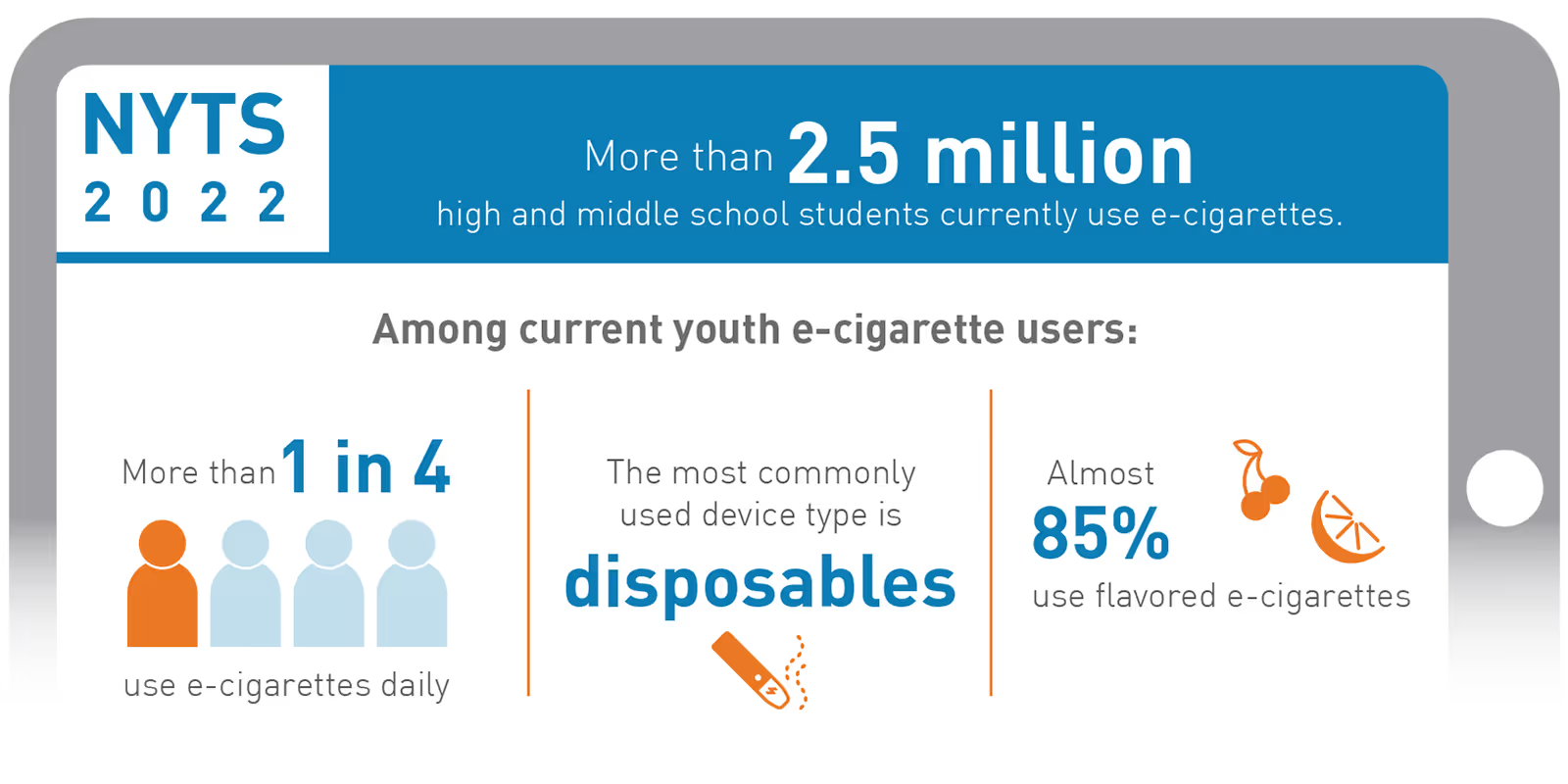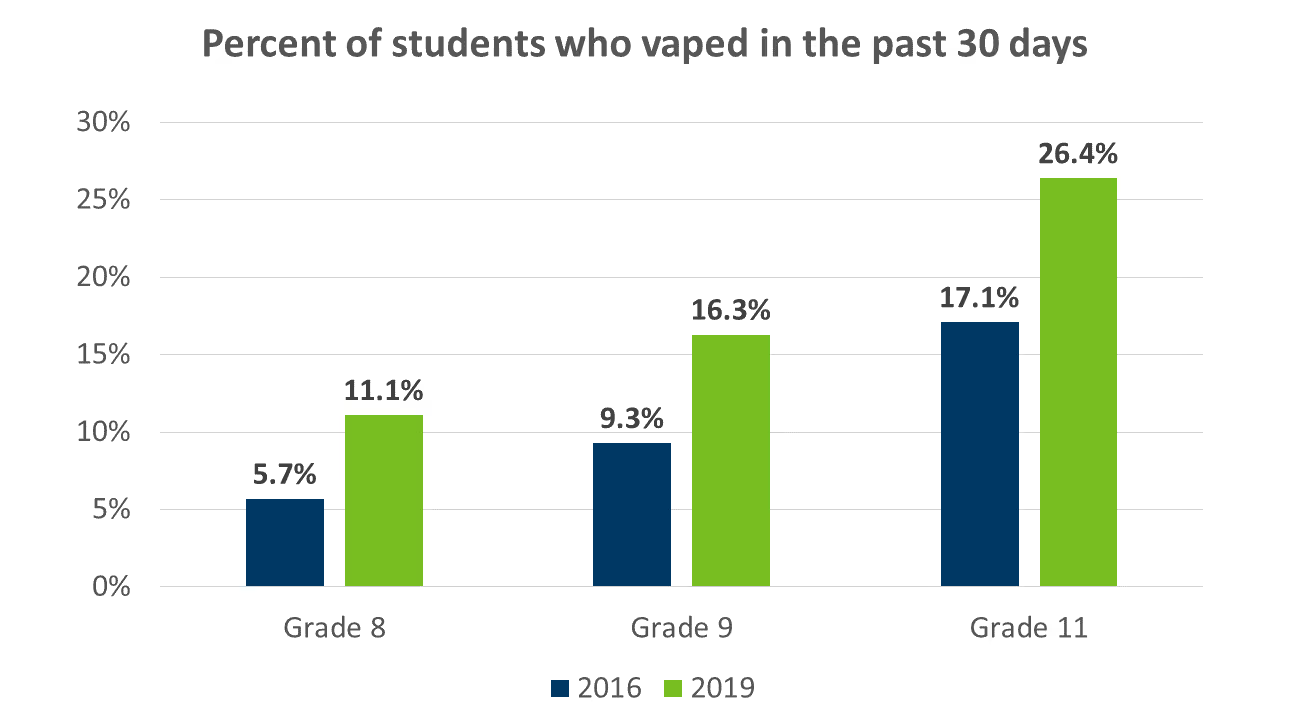41 Vaping Statistics: How Many People Vape?


Key Vaping Statistics & Facts
If you're wondering "how many people vape" or "how many teenagers vape" you've come to the right place. The fascinating vaping statistics below will answer your questions.
- 1 in 20 Americans vape, and teenage e-cigarette consumption has increased by 1,800% over the last year.
- 14.1% (2.14 million) of high school students and 3.3% (380,000) of middle school students reported current e-cigarette use.
- 11.3% (3.08 million) of middle and high-school students reported current use (in the last 30 days) of any tobacco product.
- Approximately 3.7% (1.0 million) of all students reported currently smoking any combustible tobacco product.
- There were around 55 million e-cigarette users worldwide in 2021.
How Many People Vape?
Vaping has become increasingly popular in recent years, with many people turning to e-cigarettes as a potential alternative to traditional smoking.
However, with this rise in popularity has come a lot of controversy and concern over the safety and health risks associated with vaping. In this article, we will explore vaping statistics and try to answer the question: how many people vape?
According to recent data from the Centers for Disease Control and Prevention (CDC), approximately 9 million adults in the United States currently use e-cigarettes.
This number has increased significantly over the past decade, with a sharp rise occurring between 2017 and 2018. In 2017, there were approximately 2.8 million e-cigarette users in the U.S., but by 2018 that number had jumped to 3.6 million.
Number Of Vapers By Country
How Popular is Vaping?
- In a survey conducted by the National Health Interview Survey (NHIS) in 2019, it was found that approximately 4.5% of adults in the United States currently use e-cigarettes. This may not seem like a large percentage, but when you consider that this equates to around 11 million people, it becomes clear just how popular vaping has become.
- The NHIS survey also found that among adults aged 18-24, the prevalence of e-cigarette use was particularly high at 7.6%. This suggests that vaping is especially popular among younger generations.
- Another interesting statistic comes from a survey conducted by the World Health Organization (WHO) in 2020. According to their data, there are currently over 41 million vapers worldwide. This number is expected to continue rising in the coming years as e-cigarettes become more widely available and socially acceptable.
- It's worth noting that while vaping may be popular among certain age groups and demographics, there are still many people who have never tried it or who actively avoid it. In fact, according to a Gallup poll conducted in 2019, only around one-third of U.S. adults have ever tried an e-cigarette.
How Many Teens Vape?
14.1% (2.14 million) of high school students and 3.3% (380,000) of middle school students reported currently using e-cigarettes.

Vaping Statistics By Age
- According to the CDC, the highest prevalence of e-cigarette use is among adults aged 18-24, with 23.5% reporting current use.
- Adults aged 25-44 have the second-highest prevalence of e-cigarette use, with 17.4% reporting current use.
- The prevalence of e-cigarette use decreases with age - only 6.7% of adults aged 65 and older report current use.
- Among middle and high school students who reported using e-cigarettes in the past month, over half were aged 15-17, according to data from the NYTS.
- The same dataset showed that approximately one-third of youth e-cigarette users were aged 18 or older.
While e-cigarette use is most prevalent among adults, there is also a growing number of young people who are taking up vaping. According to a study by the National Institutes of Health (NIH), more than 5 million U.S. middle and high school students reported using e-cigarettes in 2019. This is a significant increase from just a few years ago, when e-cigarette use among young people was relatively uncommon.

Vaping Statistics By Gender
While e-cigarette use is prevalent among both men and women, there are some differences in the prevalence of use between genders. Here are some vaping statistics by gender:
- According to the CDC, in 2019, 4.7% of adult men reported current e-cigarette use, compared to 4.3% of adult women.
- Among high school students who reported using e-cigarettes in the past month, a higher percentage were male than female - 12.6% of male students vs. 8.3% of female students, according to data from NYTS.
- In a study published in the Journal of Adolescent Health in 2020, researchers found that among young adults aged 18-24 who used e-cigarettes, men were more likely than women to use them frequently (defined as using e-cigarettes on at least half of the days in the past month).
- Another study published in Nicotine & Tobacco Research in 2020 found that while overall rates of e-cigarette use were similar between men and women, women were more likely than men to report using flavored e-cigarettes.
These statistics suggest that while there may not be significant differences in overall rates of e-cigarette use between genders, there may be some variations in patterns and behaviors associated with vaping based on gender.
U.S. Vaping Statistics
- In 2018, approximately 20% of high school students reported using e-cigarettes in the past month, according to data from the National Youth Tobacco Survey.
- The same dataset showed that almost 5% of middle school students reported using e-cigarettes in the past month.
- Among adult e-cigarette users in the U.S., over half also reported being current smokers of traditional cigarettes.
- According to a study published in JAMA Network Open in 2020, adults who vaped were more likely to report having chronic bronchitis symptoms compared to non-vapers.
- The CDC reports that there have been over 2,800 cases of lung injury associated with e-cigarette use as of February 2020. Of those cases, 68 resulted in death.
Why Do People Vape?
- According to a survey conducted by the National Institute on Drug Abuse (NIDA), some people turn to e-cigarettes as a way to quit traditional smoking. In fact, around 60% of adult e-cigarette users in the U.S. reported using the device as a means of quitting or reducing their cigarette use.
- Some people also use e-cigarettes as a way to avoid the harmful chemicals and tar associated with traditional smoking. A study published in the Journal of Addiction Research & Therapy found that over 80% of participants who switched from smoking to vaping reported improved respiratory function and overall health after just one month.
- Another reason why people vape is for social reasons. According to a survey conducted by Vape Club, approximately one-third of vapers in the UK said they started vaping because friends or family members were doing it.
- Some people also enjoy experimenting with different flavors and trying new products. In fact, according to data from Vape Club, fruit flavors are the most popular among UK vapers, followed by dessert and menthol flavors.
- Finally, some people turn to e-cigarettes as a way to reduce stress or anxiety. While more research is needed on this topic, some studies have suggested that nicotine may have calming effects on the brain and may help reduce symptoms of anxiety in certain individuals.
One of the reasons for the rise in e-cigarette use among young people is the wide variety of flavors that are available. Many e-cigarette companies market their products with flavors that appeal to young people, such as fruity or candy-like flavors. This has led to concerns that e-cigarettes are serving as a gateway to traditional smoking, with young people becoming addicted to nicotine through vaping and then transitioning to cigarettes.
Vaping vs. Smoking Statistics
- According to the American Lung Association, cigarette smoking is responsible for more than 480,000 deaths per year in the United States alone.
- In contrast, while there are still many unknowns about the long-term health effects of vaping, it is generally believed to be less harmful than traditional smoking. According to a report by Public Health England, e-cigarettes are approximately 95% less harmful than smoking.
- The same report also found that switching from smoking to vaping can result in significant health improvements within just a few weeks. For example, after two to five years of quitting smoking and switching to vaping instead, an individual's risk of stroke could fall to almost the same level as someone who has never smoked.
- A study published in the Journal of Aerosol Science found that the levels of harmful chemicals like formaldehyde and acrolein were significantly lower in e-cigarette vapor compared to tobacco smoke.
- However, it's worth noting that while vaping may be less harmful than traditional smoking, it is not without risks. For example, some studies have suggested that e-cigarette vapor can cause lung damage and inflammation over time. Additionally, there have been cases of severe lung injury associated with vaping products containing THC (the psychoactive component in marijuana) or vitamin E acetate.
While more research is needed on the long-term health effects of vaping, these statistics suggest that e-cigarettes may be a safer alternative to traditional smoking for those who are trying to quit or reduce their use of tobacco products.
Alarming Increase in Vaping-Related Illnesses and Deaths
An alarming trend in vaping statistics is the increase in illnesses and deaths related to vaping. In 2019, there were over 2,800 cases of lung injury associated with vaping, and 68 deaths were reported. This represents a significant increase from previous years.
The exact cause of these illnesses is not yet fully understood, but it is believed that they are related to the use of e-cigarette products containing THC, the psychoactive component of marijuana. According to the Centers for Disease Control and Prevention (CDC), about 82% of patients with vaping-related lung injuries reported using THC-containing products.
These statistics highlight the need for caution when using e-cigarettes and other vaping products, particularly those that contain THC. The long-term health effects of vaping are still unknown, but it is clear that there are immediate risks associated with their use.
Despite these concerns, many people continue to use e-cigarettes as a potential alternative to smoking. Some studies have suggested that vaping may be less harmful than traditional smoking, although more research is needed to fully understand the health risks associated with e-cigarette use.
Conclusion
In conclusion, the statistics presented in this article highlight the complex nature of vaping and its impact on individuals and society as a whole. While e-cigarettes may offer a potential alternative to traditional smoking, there are still many unknowns about their long-term health effects and risks associated with their use.
The rise in vaping-related illnesses and deaths is a cause for concern, as is the increasing number of young people who are taking up vaping. It is important for individuals to make informed decisions about their use of e-cigarettes, and for policymakers to continue to monitor and regulate this rapidly evolving industry. By staying informed and aware of the potential risks and benefits associated with vaping, we can work towards creating healthier communities and reducing the harm caused by tobacco products.
If you or a loved one are experiencing an addiction of any kind, reaching out for help can be a vital step toward healing and recovery. If you are seeking an addiction treatment center in Columbus, Ohio for help with a drug or alcohol addiction, contact the team at Dove Recovery today.
Sources:
- Centers for Disease Control and Prevention. (2020). Quick Facts on the Risks of E-cigarettes for Kids, Teens, and Young Adults. https://www.cdc.gov/tobacco/basic_information/e-cigarettes/Quick-Facts-on-the-Risks-of-E-cigarettes-for-Kids-Teens-and-Young-Adults.html
- National Institutes of Health. (2020). Vaping. https://teens.drugabuse.gov/drug-facts/vaping-nicotine-e-cigarettes
- U.S. Food and Drug Administration. (2020). Vaping Illnesses. https://www.fda.gov/news-events/public-health-focus/lung-injuries-associated-use-vaping-products
